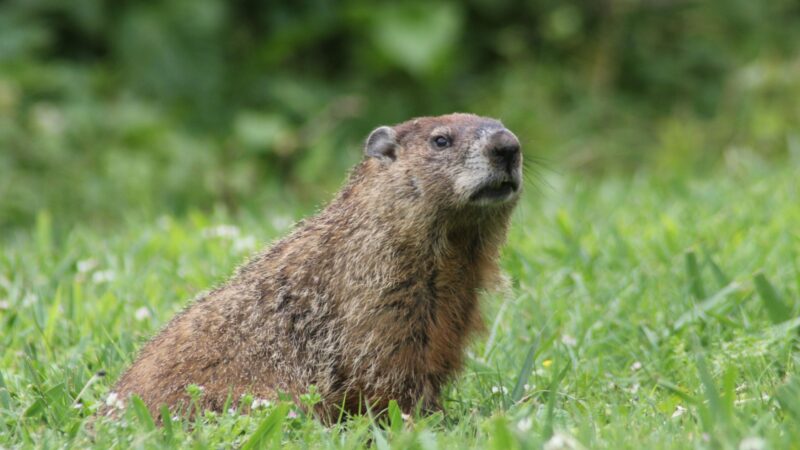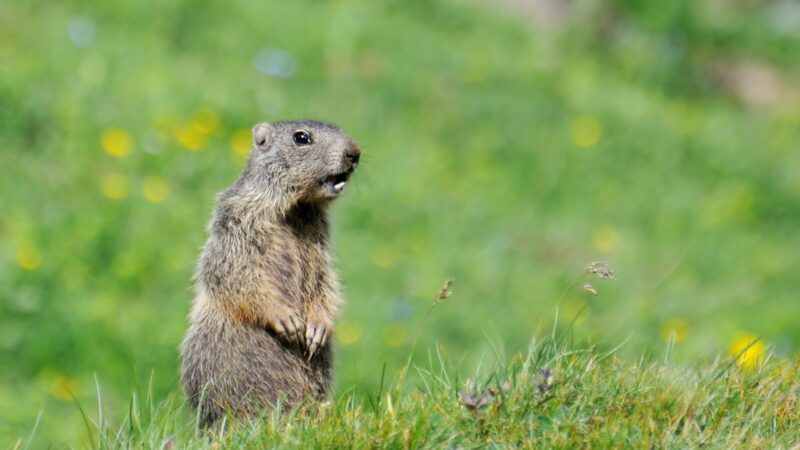If you spot some mammals in your yard that are somehow larger than ground squirrels, they are very likely to be groundhogs. Despite being closely related to squirrels, these digging critters behave differently.
Aside from being nuisance pests in yards and gardens, they can also eat your entire vegetable garden.
How to get rid of groundhogs? Getting rid of groundhogs can be done using repellents. Trapping groundhogs are more effective, but it needs a lot of patience. But since these mammals can be very persistent, installing motion-activated sprinklers is a good idea. For better results, install fences around your yard.
Groundhogs are seasonal pests but are also beneficial. This is why it is quite difficult to decide what to do with them. The key here is to have complete knowledge about their behavior before taking any action.
In this guide, you will learn interesting facts about groundhogs and how to control them effectively.
Table of Contents
What Are Groundhogs?

The scientific name of groundhogs is Marmota monax, and they are not hogs or pigs. Instead, they belong to the family Sciuridae, which includes chipmunks, marmots, prairie dogs, and squirrels.
These ground-dwelling rodents can be found in Asia, Europe, and North America, including Canada and Alaska.
Every February 2nd of the year, Americans and Canadians celebrate Groundhog Day. According to beliefs, groundhogs can predict the weather for the next six weeks.
A groundhog named Punxsutawney Phil is said to be predicting the weather since 1886. If this is true, this groundhog is more than 135 years old!
Is a Groundhog a Woodchuck?
A groundhog is also a woodchuck, which is the animal’s most famous nickname. The name “woodchuck” is believed to have come from the Native American word, woodchook or woodshaw.
Groundhogs don’t chuck wood, though. Other common names of groundhogs are whistlepig and land beaver.
What Do Groundhogs Look Like?
Groundhogs look like huge squirrels, except that they have shorter, fluffy tails. These woodchucks also resemble marmots but are slightly larger, with a brown, grizzled appearance and less color.
Adults are 16–26 inches (40-66 cm) long, with a tail length of 4-6 inches (10-15 cm), and weigh 6-12 pounds (2.7-5.4 kilos).
Groundhogs have short ears, black or dark brown short but powerful legs, and glossy guard hairs. Both sexes have the same color, but males are a bit heavier than females.
Like all rodents, their big incisors are rootless and grow endlessly. Their two front feet have 4 toes each, while their two hind feet have 5 toes each.
How Long Does a Groundhog Live?

In the wild, groundhogs live for 4-6 years. In captivity, their lifespan is 10 years or more. Aside from Punxsutawney Phil, its cousin named Milltown Mel is also the star of Groundhog Day in Milltown, New Jersey.
This groundhog has been predicting weather since 2015. He passed away in 2020, at the age of almost 7.
How Deep Is a Groundhog Burrow?

Groundhogs have excellent burrowing skills and dig several underground nests in dry, well-drained soils.
Groundhog burrows are usually interconnected, with each having about 6 inches (15 cm) in diameter and 2-4 feet deep. The length is 15-25 feet (4.5-7.6 m), but some burrows can be up to 100 feet (30.5 m) long.
Each burrow has a main entrance, which is typically marked by a fan-shaped mound of freshly excavated soil. These groundhog dens have five or more plunge holes, which are well-covered by plants.
These dens will be used by several generations of groundhogs and will be more complex and have more exit holes.
What Month Do Groundhogs Come Out?

Groundhogs hibernate and are true hibernators. They come out in February or March, depending on the temperature in their area. The hibernation period typically takes 2-5 months.
Groundhogs are mostly active from spring until fall, October, or November, or when the weather starts to get cold and plants begin to die.
What Time of Day Do Groundhogs Come Out?
Being diurnal mammals, groundhogs are most active during daytime hours and rest at night. These shy creatures generally come out from their dens during the early morning and late afternoon to find food.
During summer, they spend the hottest time of the day underground and will be active again in the early evening.
Can Groundhogs Damage House?

If ignored, groundhogs can eventually damage houses. As mentioned earlier, they tend to extend their burrows, which may reach residential and building foundations.
In most cases, groundhogs build two kinds of dens – winter dens and summer dens. These burrowing mammals can also damage crop fields.
Do Groundhogs Climb Trees?
Groundhogs climb trees to find leaves to eat and to escape from predators. With their strong upper body and sharp claws, they are famous for being fast tree climbers.
Aside from that, groundhogs are also good swimmers. But in most cases, they prefer foraging on the ground or staying in their underground nests.
Can a Groundhog Climb a Fence?
Being great climbers, groundhogs can also climb fences. Generally speaking, they can climb fences that are about 3 feet high. This is why standard fences are not ideal solutions to prevent groundhogs from invading your property. Higher fences are tough for them to climb since they are heavy and their legs are short.
Are Groundhogs Afraid of Humans?
Groundhogs are not afraid of humans. This is also why they dig burrows in lawns and gardens, or close to human habitats. Despite being wild animals, woodchucks don’t mind living close to people.
But being solitary animals, they prefer being alone and avoid being seen by humans, as well as larger animals.
Are Groundhogs Dangerous?
Groundhogs are not considered dangerous unless a rabid groundhog bites you. But again, these proficient diggers are not inclined to interact with humans and pets.
Nonetheless, if you spot a wounded or sick groundhog or a kit (baby groundhog) in your yard, don’t pick it up. Instead, call a local wildlife rehabilitator.
Can a Groundhog Be Aggressive?
Groundhogs can be aggressive to humans but in very rare cases. Despite being territorial, these burrowing rodents are unlikely to attack for no reason. In most cases, they may run away and hide in burrows when chased.
But when cornered, mother groundhogs will bravely defend their babies and bite humans.
Can a Groundhog Hurt My Dog?
Groundhogs can hurt your dog, especially if it is a smaller breed. But again, most groundhogs avoid confrontation and prefer escaping and hiding in burrows.
If a huge dog chases a groundhog and the latter has nowhere to hide, that dog may win the fight. Nevertheless, the sharp claws of groundhogs can injure dogs.
Do Groundhogs Carry Lyme Disease?
Groundhogs don’t carry Lyme disease unless they have ticks that carry this illness. Scientifically known as Ixodes cookei, groundhog ticks (or woodchuck ticks) feed on mammals, including cats, dogs, foxes, raccoons, and groundhogs. Lyme disease can be transmitted to humans who are bitten by infected ticks.
Does a Groundhog Carry Rabies?
Groundhogs carry rabies, along with bats, raccoons, and skunks. In fact, the Centers for Disease Control and Prevention (CDC) noted that 93% of the 371 rabies cases of rodents from 1990 to 1996 were associated with groundhogs. This is why you should not touch groundhogs with bare hands, even their babies.
Are Groundhogs Bad for Your Yard?
Groundhogs are bad for your yard. They will not only damage your property by digging long and deep burrows but will also eat your grass. These omnivores also eat flowering plants, including alfalfa and clover.
Believe it or not, a small vegetable garden can be wiped out by a family of groundhogs within only a week.
Are Groundhogs Good for Anything?
Groundhogs are also good for the environment. Despite being vectors of rabies and garden destroyers, groundhogs help in aeration and mixing the soil.
While digging, they are feeding the soil with oxygen that plant roots need. During mixing, the surface nutrients are also dispersed to the deeper part of the soil.
Researchers and medical experts are also now studying groundhogs for a potential cure for the Hepatitis B virus.
Groundhogs are the only animal that can be infected with a similar disease, which is called the woodchuck hepatitis virus (WHV). Since these creatures are fat, they are also being studied for obesity treatment.
What Is a Natural Way to Get Rid of Groundhogs?
The natural way of getting rid of groundhogs is to trap them alive. Although using lethal traps is legal in some states, killing these animals is never a guarantee that no more groundhogs will enter your property.
Relocating groundhogs is also legal in some states. Just make sure that the animal will survive in its new habitat.
Does Irish Spring Soap Keep Groundhogs Away?
Irish Spring soap can keep groundhogs away because of its scent. It can also deter deer, skunks, and raccoons. To repel groundhogs, cut the soap into small pieces.
Hang them on trees or place them near the burrow opening. But since the smell will soon be gone, Irish Spring soap is not a permanent solution.
Will Human Urine Keep Groundhogs Away?
Human urine can keep groundhogs away. Simply pour it into the opening of the groundhog burrows, and the animals inside will soon be forced to leave. This technique is humane but may not be that effective.
Just like soap, the foul smell will eventually go away. Therefore, you need to pour human pee again and again.
Will Vinegar Get Rid of Groundhogs?
Vinegar can repel groundhogs since these wadding critters cannot tolerate its pungent odor. To make it more effective, mix white vinegar with a few drops of ammonia and pour the mixture into the burrows.
But again, any scent that you will use against groundhogs needs reapplication and could be time-consuming.
What Do You Do If You Have a Groundhog in Your Yard?
Having a lone groundhog in your yard may not cause a major problem. But it does not mean you should ignore it. A pregnant groundhog gives birth within a month in their burrows and can have 2-6 kits (also called pups or chucklings).
With that, here are some tips you can do if you have groundhogs in your yard:
1. Locate the Burrows
As mentioned earlier, there could be at least 3 groundhog burrows in your yard. They are also likely to be connected. These dens can be under a shed, deck, or even your house foundation. Aside from the entrance, these dens have multiple exits, which are usually covered by plants, leaves, and debris.
2. Know When to Evict Groundhogs
Groundhogs usually mate in March or April, and their offspring are likely to leave the den in July. Therefore, avoid doing any action while the kits are still dependent on their mother. Otherwise, these poor babies will die of starvation. Groundhogs will also die in the cold if you evict them during the hibernation period.
3. Place Groundhog Traps
Groundhogs are normally in their dens at night, and Havahart 1085 Live Animal Trap is the ideal trap to use. Seal the exit holes, and place groundhog traps very close to the burrow entrance.
You can use apple slices, cabbage, carrots, or lettuce as bait. Block other paths to make sure that groundhogs will enter the traps.
4. Apply Groundhog Repellents
Pour or sprinkle groundhog repellents such as ammonia, garlic, humane urine, Irish Spring soap, or vinegar near the opening or inside the dens. You may also use loud noise, such as the banging of metals.
Since not all animals inside the dens may come out, repeat the application every night and check the traps every morning.
5. Test and Close the Burrows
Cover the burrow entrance with grass clippings, leaves, or newspaper. If they are still in place for the next 3-5 years, you can now assume that the burrows are already empty.
Cover them completely with heavy-gauge, welded wire. To make sure that groundhogs cannot remove the wire, bury it at least 1 foot deep.
6. Install an In-Ground Fence
Since ordinary fences don’t work against groundhogs, you need to install an in-ground fence. Use galvanized hardware cloth such as Amagabeli 1/4-Inch Hardware Cloth. Bury the fence at least 1 foot underground and bend another 1 foot horizontally to form an L-shape. The height should be at least 4 feet high.
7. Install Motion-Activated Sprinkler
If your yard is large, fencing can be expensive, and installation requires lots of digging. As an option, you can scare groundhogs that will enter your property using Havahart 5277 Motion-Activated Sprinkler. This eco-friendly device can detect animal heat and movement within 60 feet, and it has 4 different settings.
Summary
Exclusion fences are effective against groundhogs. However, trapping them can be challenging because of the design of their burrows. Different states also have different laws about relocating wild animals.
More importantly, most groundhogs are rabies carriers. If you have doubts, contact a groundhog removal professional.
List of Sources
Ecology and Management of the Groundhog (Marmota Monax)